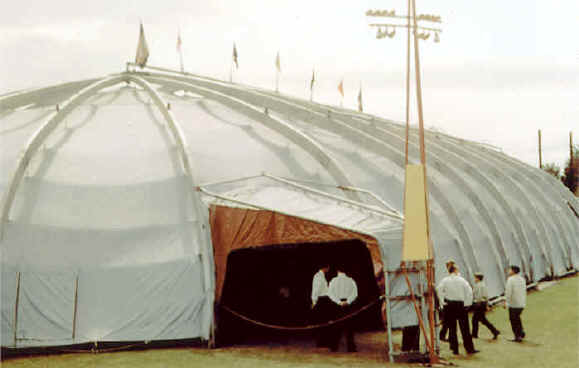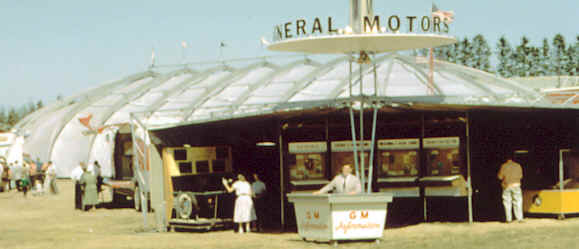HOME
'33
World's Fair
1936
Parade
1938 Previews
1941
Parade
1953 Parade
1954 Parade
Aero-O-Dome
Erecting Tent
Page 2
Page 3
Page 4
Inside Tent
Showtime
Page 2
Audience
Exhibits
Demonstrations
Appreciation Letters
Futurliner
In-Line Six
Other Futurliners
Paraders
Oral
Roberts Cathedral Cruiser
|

One of the more spectacular new pieces of
equipment for the 1941 Parade of Progress show was the new 1,500 person tent. The tent was
radical and broke all the rules of traditional tent design. At first glance it looked like
an inverted umbrella with ribs exposed. The frame was made of aluminum while the silver
skin was plastic-impregnated to make it light-proof, water-proof and yet light in weight.

The tent was illuminated on the outside with colored flood
lights and on the inside, it was lighted with multi-colored fluorescent tubes.
Inside the tent, research lecturers gave a 40-minute
demonstration. They described new developments in industrial research which contributed to
national strength and which gave promise of future improvements of importance.
To erect the tent, everything was bolted together except
one end of each girt and its corresponding girder, forming the jointed tent ridge. This
was a final manual operation after the remainder of the framework had been raised. More
than 25,000 spot welds were required to make the frame. To raise the frame a truck is used
to pull the cable, that raised the framework of the tent into position. Sections of the
tent material are hand laced together. The tent fabric is snapped to wires which are run
through pulleys in the rigging of the frame. The huge silver covering was then pulled into
position.
AER-O-DOME ASSEMBLY
-
The men of the parade
take the framework's sections from a specially built trailer. The
frame consists of 56 pieces of metal plus 28 arched girders and 28
tubular connecting links. About 25,000 spot welds were required on
the frame.
-
Next, the men lay most
of the frame on the ground and bolt it together. A winch then
hoists up the frame. At the top of the frame, at each end, is a
semi-circular piece of metal called a "spider." When the
main frame is up, a crewmember goes aloft and bolts the end
girders into place on the spider's metal projections or
"ears."
-
Other crewmen,
meanwhile, have been lacing the skin's five large pieces together.
(The skin's weight: 4,594 pounds; area: 3,445 square yards.)
- Then, with snaps and pulleys, the skin is pulled into place.
It slides evenly along in tracks on the underside of the
girders. Finally, all vertical seams and horizontal bands are
roped with some 2-1/2 miles of hemp line.
ADDITIONAL DETAILS
-
There are 10
ventilators in the top.
-
All the "running
rigging" (attached to skin) and "standing rigging"
(attached to frame) is roped with 9-16-inch linen line.
-
The stage in the Aer-O-Dome
is part of a specially constructed 32-foot trailer. Sides
of the trailer open hydraulically to form the stage overhead as
well as the stage apron, complete with lights.
-
Stage curtains are
operated electrically. similar controls work the 9 by 12 foot
movie screen suspended behind the curtain truck.
-
A proscenium arch of
brightly colored sheet aluminum panels, mounted on a framework of
aluminum tubing, forms the stage masking.
-
The background of
three-dimensional moving objects -- for an "atomic age
effect" -- may be bathed in "black light" from a
bank of overhead lamps.
|

